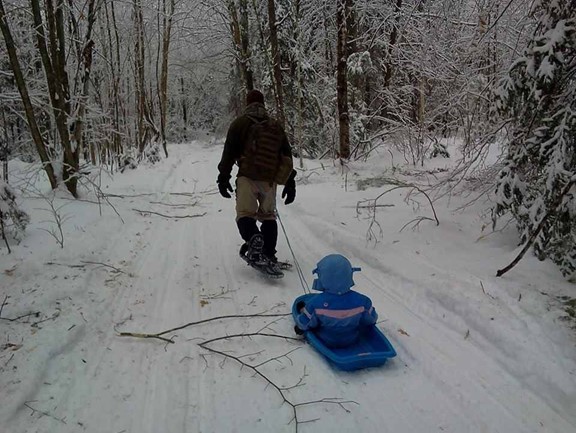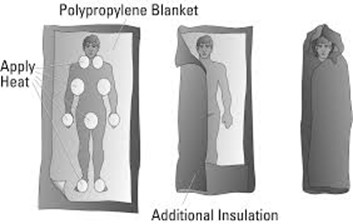Solar Energy Generator for When TSHTF
(Originally posted a few years ago. I’m reposting because of interest generated when I mentioned it in an article written earlier this week.)
———————-
Over the last few months I’ve been reading various accounts of how people have been making their own solar generators and I knew that I had to give it a try. Think about it! Spend a few hundred bucks and you basically have a power source sitting in the house ready to go at any time that never needs gasoline, kerosene, or any other fuel except the sun. How cool is that? Why would I want a solar power generator? For a quick look at peak oil and what the government is doing about it check this out.
Parts
You will need a solar panel, charge controller, deep cycle battery and an inverter plus assorted wire and wire connectors. You can either leave it sitting on a bench or put it in some kind of housing system, which I’ll cover later.
Solar Panel
The solar panel sits in the sunshine and delivers electricity to your system. How much juice gets delivered depends on the panel. This is a smaller system so I decided to try and get away with a small 20 watt panel. The good thing about these is that you can usually hook them up together to deliver more electricity.
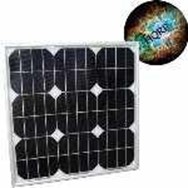
For the solar panel I bought a HQRP 20W Mono-crystalline Solar Panel 20 Watt 12 Volt in Anodized Aluminum Frame plus HQRP Coaster from Amazon. It got good reviews and so I decided to give it a try. Price: $100.
Charge Controller
This device sits between the battery and the solar panel and regulates how much charge the battery gets. It monitors the battery and will stop charging once it’s full, so that it doesn’t get damaged. Here’s the description right off the web site:
- Charge controller prevents overcharging of 12-volt batteries
- Intended for use with 12-volt solar panels
- Handles up to 7 amps of array current and up to 100 watts of solar power
- Charging light indicates the battery is charging, and a green light indicates a fully charged battery
Measures 4 x 1 x 2.5 inches (WxHxD) and weighs one pound
Price for the charge controller: $19.89
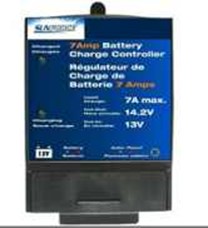
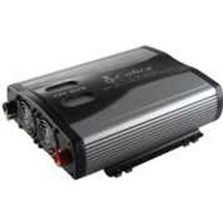
Inverter
This is what actually delivers 120 volt power to your devices. It takes the 12 volts of electricity from your battery and converts it to 120 volts through some modern magic. The one I bought can also be hooked up to a car or truck.
This is a Cobra CPI 1575 1500 Watt 12 V DC to 120 V AC Power Inverter and costs $98.95.
Battery
The deep cycle battery is what holds the electricity for the system. If you have large electricity demands you’ll need more than one battery in your battery bank. I bought a deep cycle marine battery from Walmart for around $100.
I figure that three batteries hooked together in parallel will be enough to meet my needs in case of a 24 hour power outage.
Next – Putting It All Together
The first thing I did was hook the inverter up to the battery to see how well it worked. Beautifully, as it turns out. I ran a drill off it as a test and currently I’m running my laptop, external speakers, and a lamp and after two hours of use haven’t noticed much drop in the battery’s voltage. It started out at 12.3 volts and is currently sitting at 12.1 V. Needless to say if you’re in a black out situation you could run several small items like these. One of the cool things about the inverter is that it has a USB port so you can charge your MP3 players or whatever directly from the device while it’s turned on. Pretty sweet!
Once the inverter was connected to the battery I hooked up the charge controller like this:
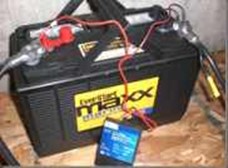
Next I hooked the solar panel to the charge controller and set the panel outside to start charging.
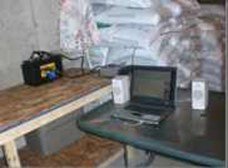
The wire from the solar panel to the charge controller can be seen being held in place by a pellet bag just above the laptop.
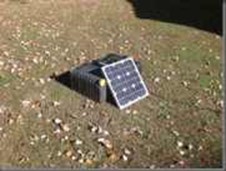
Small Solar Panel
How big an inverter do you need? The first thing to do is figure out how much power you’ll need if the power goes out. I want to be able to run a pellet stove or a freezer, so let’s use the freezer as an example. *Warning* Geeky stuff follows.
You can usually find the electrical information on the back of the appliance, but if you don’t see it a trusty Google search can usually help you get the information you need. My freezer uses 115 volts and 5 amps for a total of 575 watts. (volts x amps = watts) I have a 1500 watt inverter, so even factoring in the startup voltage (motors have a higher energy draw when they first start up) I still have enough power in the inverter to comfortably run this device.
I could also run the laptop and a few other small gizmos, but if you tax the inverter too heavily it needs to shut down and allow time to cool off every once and awhile. Still, the freezer doesn’t run continuously, so it should be fine.
The Battery Bank
Granted, one battery isn’t much of a bank, but I’ve pretty much determined at this point that the system isn’t going to get a lot of heavy use. I figure that one 120 amp hour deep cycle battery could run the freezer continuously for roughly three hours before it dies.
Testing
In the last few days the laptop and speakers have run off the system without any problem at all. I haven’t yet tested the voltage being produced at noon, but I have noticed that the battery is being charged up 12.5 volts during the day thanks to some sunny skies. So far the system has been a success and my girlfriend thinks it’s pretty cool too.
Other Stuff
There are a lot of things I haven’t touched on here due to the amount of information I had to dig through. For example: batteries create hydrogen when they’re charging and need to be properly ventilated. Battery maintenance in and of itself is a huge part of a solar array.
Cabling is another factor. I’m using #14 wire used to run electricity to outdoor lighting and it should really be #12 or #10 wire, but for what I’m using it for it should work fine. When I add to the system I will have to upgrade the wiring.
Size of the system. In order to figure out how many solar panels and batteries you need and the rating on the charge controller and the inverter you need to start with what you want to run and then give it a healthy boost because we don’t have sunshine every day.
Further Plans
One more thing I want to do with this system is put it in a container. I happen to have a wheeled tool box sitting around not being used and I’m planning on putting it in that. The bottom half of the toolbox will house the battery and the top will hold the inverter.
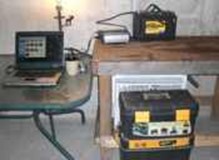
Containment System (an old toolbox)
There are two reasons for doing this. One is to keep it out of the way of my young son who is intensely curious about Dad’s projects and the second is because that sucker is heavy! If I’m going to wheel this thing say, out to the truck from my basement, it’s nice to have it all in one unit that I can pull along behind instead of trying to carry it.
One important note for anybody who might try to build one of these: If you do put your battery in a system like this make sure it’s vented! I’m going to put a small fan on the battery container that will vent the hydrogen out as the battery charges.
Eventually I want to add enough panels and batteries to this system to run a pellet stove off it full time. So, I’m not quite ready for the zombie apocalypse quite yet, but like the rest of you preppers I’m working on it!
Comments made:
neat project, but…
if the asteroid does hit, there will be copious quantities of dust suspended in the atmosphere. you will need to size your panel array accordingly. for the first few weeks you may not have enough daylight, regardless.
—————-
I was looking at getting involved in installing large solar farms (I have an unlimited electrical licenses).
One good is that you have not tried to tie it into your ac system. Unless you have access to lots of tax credits it adds all sorts of traps and foibles.
Be aware that when you to using disconnects etc, that the rating on dc is not necessarily the same as that for ac. DC disconnects at the same voltage are usually larger. Since your DC here is 12v it is not a problem. But if you got ambitious and started tieing panels in series it might.
To avoid voltage drop, you will want the larger wire on the lower voltage side. You may have doen that, but it is not clear. When I used 12v leds in a string under our kitchen cabinets, I used #10.
The real deal killer for me on the sun farming concept was a warning I read from an experienced installer who said that the inverters were the achilles heal. He said that they often went out within a 2 year time period. For short term emergency usage that is not such a big deal. For a hundre dollars, that inverter looks like a good deal. If you have a freezer that you store meat, etc, in you would easily save the $100 in not loosing your supplies. I am not criticizing: just commenting. I like the setup and will have to look into doing one for myself.
—————
You’re absolutely right about doing a grid tie-in. If I were to do something like that way down the road I’d hire someone like you to come in and do it. Also, I plan to keep it a 12 volt system and won’t be putting anything together in series. (For those who are wondering – if you tie two 12 volt batteries together in series you’ll get 24 volts.)
I used battery cables to tie in to the inverter, but it’s hard to see in the photos.
Due to the amount of information I had to keep the post (somewhat) brief, so left out some of these important details. I would hope that if someone does build this system they take time to do the same research I did.
—————-
As a final aside, I was not aware until recently that the trucking world has a whole alternate universe of 12 volt operating TVs, refreigerators, etc.
————
That would add a different element to the whole thing.
————-
Yes it would cause there is something like a 25% lose when stepping up voltage.
————-
ummm , if you wire the batterys in a paralle circut insted of a series you i will keep it 12V but still have all the battery power get a uglys manual i know i cant spell but i am pretty sure about this hey ranger man love the blog some of the best reading i do here in afganstan is this helping me plan my compound in the hard praires in the Midwest
—————–
Your idea is just awesome. Solar power can be considered as a great ecological energy saving, bring a new way of living and worth more than the fuel or gas generators. With a small investment, eliminate your dependency from the power company and generate your own electricity from the sun and wind by solar powered generator.
————-
I live in Miami, and have built 11 solar electric systems in the jungles of Belize…I have no vested interest in this company but some of the best prices in the USA for solar stuff is http://www.suneclec.com.
———-
BTW I agree that the inverter is the Achilles Heel of the system..there are good 12 and 24 volt freezes and refrigerators and of course there are kero/propane refeers and freezers also
————
Since I made the comment above on the low volage refrigeration, I had a conversation with an HVAC mechanic. He warned me that the system of refrigeration that these units tended to use had a very limited cooling delta. So you would need to keep them someplace that stayed relatively cool- like below grade.
Still useful, but more limited than I originally though. Might not be a bad addition to a root celler setup though.
—————
No expert here. However, please keep in mind batteries can explode. Any gas must be vented. Connecting the battery can produce a spark able to denote the gas/battery.
Not a huge issue, just something to be aware of. In my profession I’ve seen a couple batteries explode. It clears a very large area quite quickly. The gas/acid expelled after the explosion is pretty tough. Not something you would want to breath. I would keep the batteries outside my home personally. Just my 2 cents.
Sweet set up. Just might make myself one of those.
Start now to make sure you are staying prepared.
Via: shtfblog
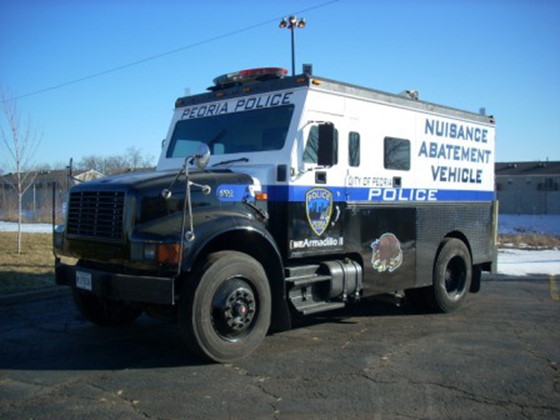
 Follow
Follow